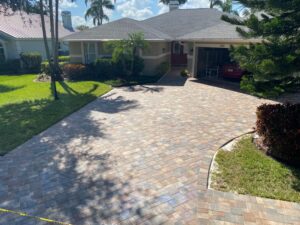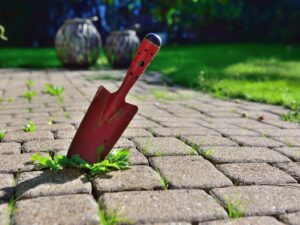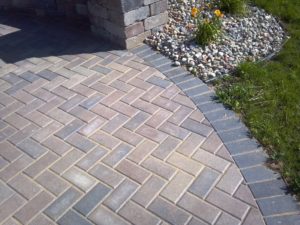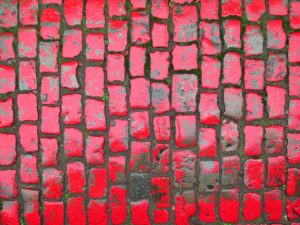Paver installations are often the base of the most intricate and elegant hardscape projects. Homeowners take a long time choosing the perfect paver to precisely fit their design, but they end up overlooking one of the most important elements of a paver installation: the paver sand.
For an interlocked paver installation to work as intended, the sand is just as important as the pavers themselves. It is the glue that holds the pavers together and allows them to shift around to accommodate even the heaviest objects.
So choosing the right paver sand is of extreme importance, and we are going to guide towards making the best possible choice.
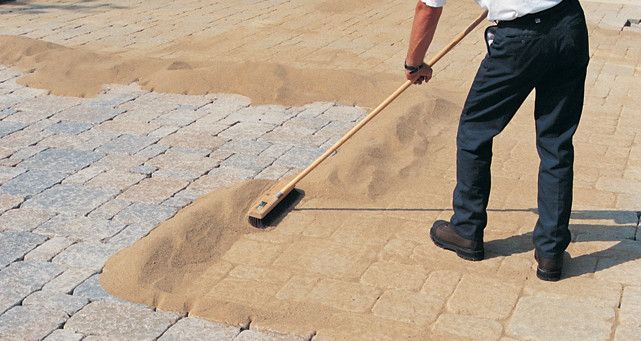
How Paver Sand is Used?
Sand has two applications in a paver installation: for the bedding and the grout lines.
At the bedding, the sand is placed on top a layer of compacted gravel or road base. At this phase, the goal it to provide for the pavers a solid yet and malleable base to be placed upon. For this purpose, any sand can be used with relative success, but the most indicated variation would be concrete sand.
The second application would be right at the end of the installation, but it is a step that is crucial for its success.
What makes pavers so good is the fact that they are installed to form an interlocked system. That means each individual paver works together to create a unique structure with very resistant individual pieces, yet able to distribute the weight evenly.
It really is an incredible system that only became more incredible the more technology was developed to improve it. What allows the system to work is the unique combination of sand and pavers, especially the sand that is used in this second application.
In this application, the sand used is not any regular sand. Instead, it is a specific type of cans called polymeric sand. This sand is composed only of fine grains mixed with specific additives. When in contact with water, this sand becomes a strong bonding agent, allowing the pavers to stay in place.
Types of Paver Sand
So let’s expand a bit on exactly what types of paver there are in the market.
Polymeric Sand
The most important kind of sand used in a paver installation. It is this sand that allows the interlocked mechanism to work. It is specially designed to be applied in the joints of pavers. Furthermore, it looks exactly like regular paver, the difference is that, when wet, polymeric sand becomes a strong bonding agent that keeps the pavers tightly locked amongst each other.
Concrete Sand
Concrete sand is a cheaper form of sand, used mostly in the creation of a base for several construction projects, the installation of pavers included. Being the cheapest form of sand, many homeowners choose to use it as joint material as well. However, this is not recommended, as this sand can be easily washed away, and it doesn’t properly protect the joints.
Masonry Sand
That would be the “regular sand”, used in general construction. People also often use it both in bedding and as joint sand. Masonry sand is basically the same thing as concrete sand, the only difference is that it is made of finer grains, and therefore a little better for joint purposes.
How to Apply Paver Sand?
Polymeric sand is applied at the end, as a final step of the installation. Once all the paver are in place, use a leaf blower to remove any dust and debris from the installation. After that, spread the polymeric sand over the entire surface of the installation.
Now, using a coarse bristled broom, you’ll sweep the sand across the installation, focusing on filling the joints between the pavers until they are completely filled.
Then, again using the leaf blower, you’re going to clean the area. But this time, work with much more caution as if not to remove the sand itself, only the fine particles that remain on the surface.
With the surface free of dust, it is time to activate the sand using water. The water should be spread using a hose using a nozzle in shower mode. Slowly douse the area with as little pressure as possible and from a safe height. Your objective is to simple wet the pavers and the sand.
You might have to apply water a second time. Wait between 1 minute and 3 before going for another round.
After the applications of water, you can use a squeegee to remove the excess and direct the water towards the joints. At the end, you can use the leaf blower one last time to remove any excess moisture that might still be on the pavers.
Mistakes Using Paver Sand
The most common mistakes when working with polymeric sand is the overfilling and under filling of the joints.
Sand on the joint should be 1/8″ below the surface of the paver. Too much and sand might accumulate on top of the pavers, too little and the interlocked system won’t work properly.
Under or over-watering can also be a problem. The watering process should be quick, at most 7 seconds on each small area on the first watering and 5 on the second watering. Don’t add too much or too little water, and if you ever see foam accumulating on the surface, stop watering immediatelly.
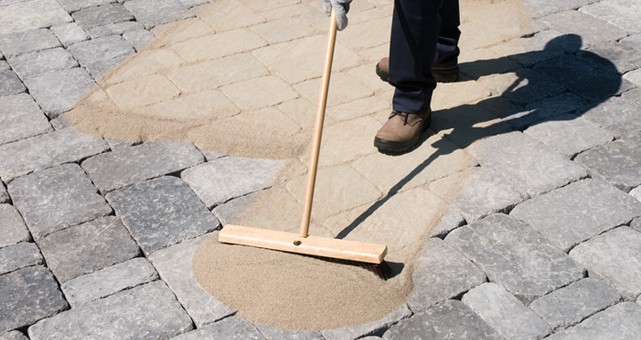
Advantages of Paver Sand
Using the correct sand for a paver installation not only guarantees the interlocked system, which is the main advantage of using pavers, works properly, but also prevents the accumulation of weeds and the activity of paver ants.
Of course, much of that also depends on a good installation, it is not like sand alone can fix a bad installation.
Proper slope, for example, is extremely important and something that if not thought from the first moments of the installation can become a huge headache in the future.
The best way to avoid these headaches is to hire professionals in the hardscape business to help you with your installation.
We here at S&S Pavers have helped many homeowners developing the paver patio of their dreams during our 12 years experience, so we know the importance of having that help available. We highly recommend you get in contact with a professional in your area.
And if you happen to be around our area of activity, the Sarasota and Manatee counties, in FL, why not give us a call to help you?
You can contact us any time for a free estimate on our services. Call us right now at 941-773-3098 or email us at sales@sspavers.com. We would be happy to hear from you.

